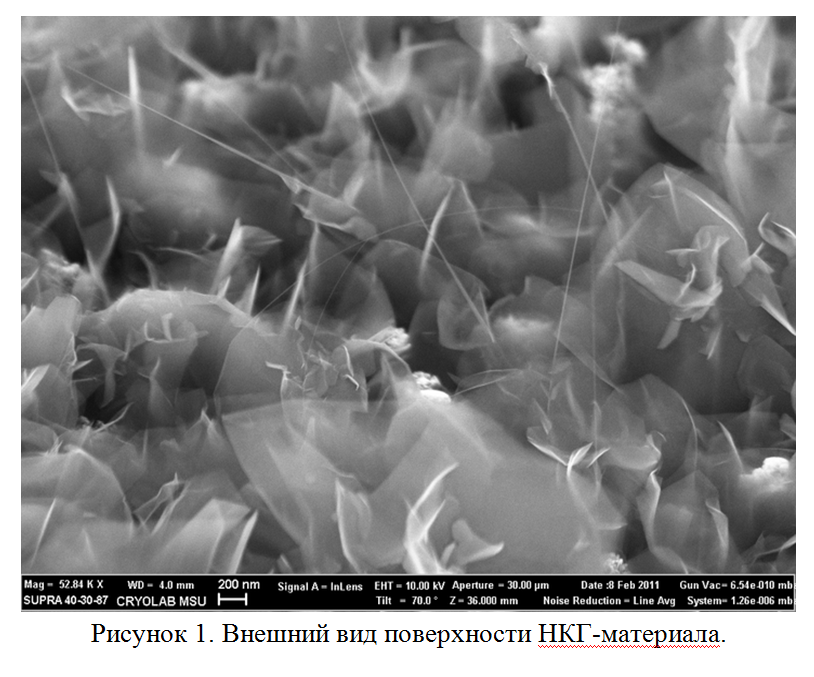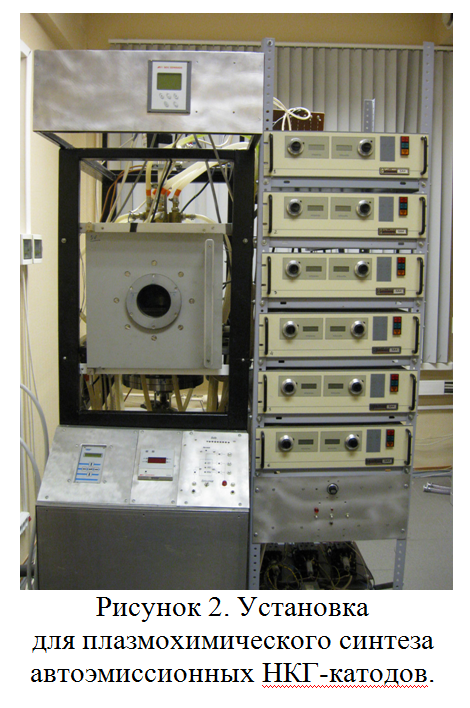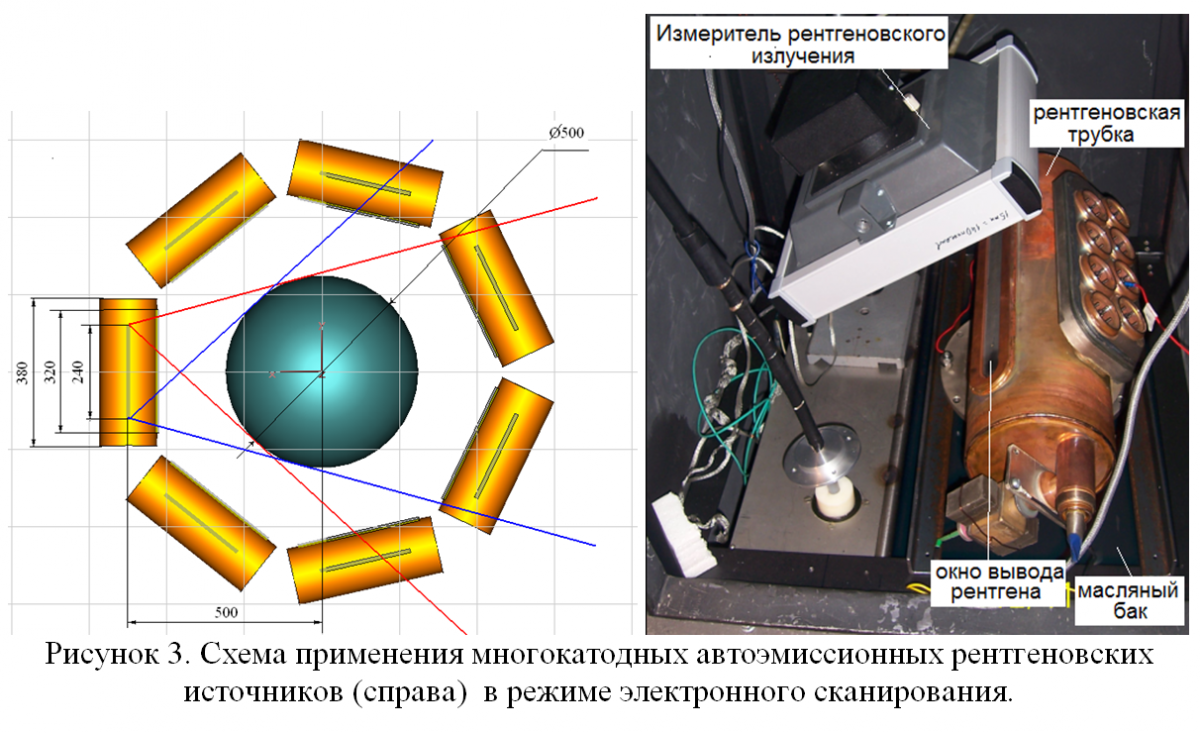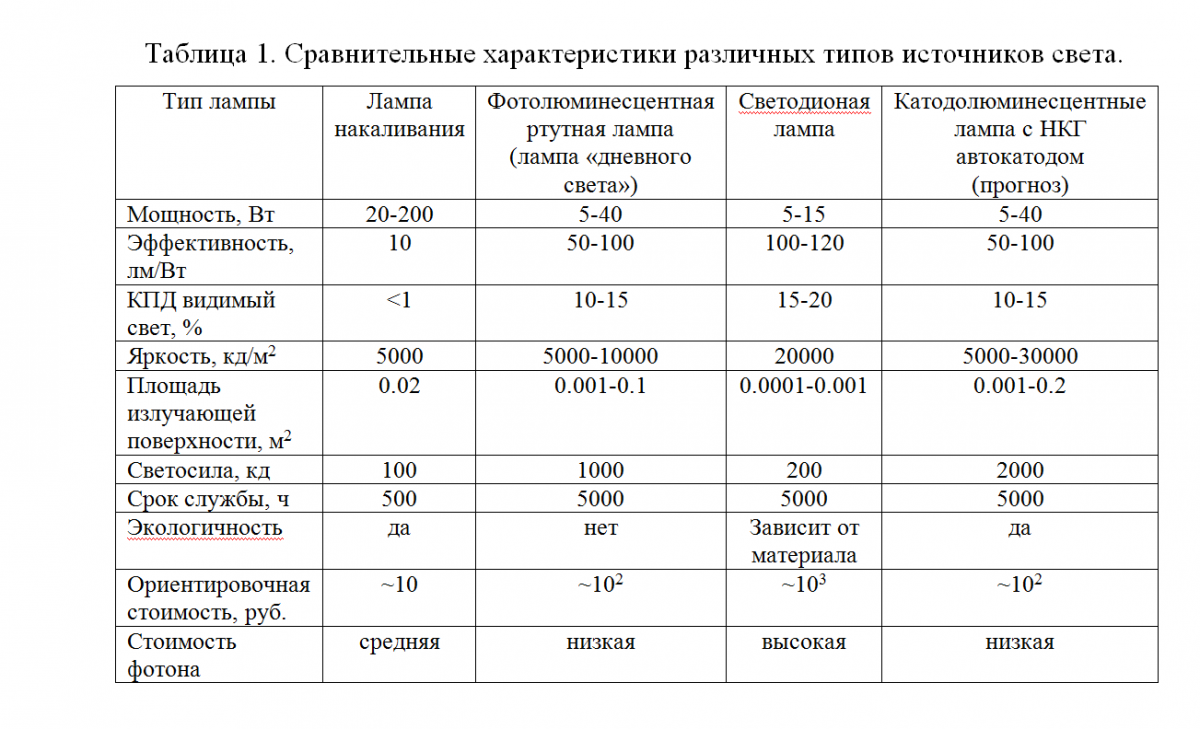SINP sientists developed nonostructural material with unique auto-emission properties which gives him a number of advantages for vacuum electronics applications including x-ray sources, light sources, vacuum UHF equipment, neutralizators of ion flux charge.
Recently carbon nanomaterials are an object of focused attention of the researchers. The reason is that nanostructures provide a number o unique properties connected with size effects in the basis of a number of electronics applications. The most challenging types of carbon nano-sized structures from the point of application are nanotubes and graphene characterized with high electronic conductivity and relatively low effective work function.
But inspite of unique properties the most part of devices based on using of singular nano-sized carbon structures does not go out of the laboratories. It can be explained by absence of effective technologies which on one hand allow to organize volume production of these devices, and on the oter hand provide decreasing of production costs down to economically viable level. Therefore the most promising directions of carbon nanostructures using are still based on the using of thin films consisted of the arrays of nano-sized structures.
In order to increase efficiency of electro-vacuum devices operation, for instance, miniature X-ray tubes, compact microwave amplifiers, etc., carbon films must provide auto-emission properties homogenuous on the surface, high adhesion to the base and the conductive to high currents. Besides, increasing of the device's lifetime is directly connected with decreasing of auto-cathode's degradation degree as a result of currents flow. Methods based on the coating of carbon-containing plasma films satisfy all these criteria. The final properties of the carbon films are determined with the processes in plasma during their synthesis.
Nanocrystallic graphite. NCG-material [1-3] developed by SINP scientists is formed as thin films which can be deposited both on conductie and on dielectric bases by vapor-phase syntheis without growth catalyst. NC films provide characteristic micro-edge texture (see Figure 1) which produced by mainly vertically oriented graphite plates of different thickness and also contain some nanowhiskers.

NCG films were synthesized by method of plasma-chemical deposition in the direct current discharge. Besides, a new method for production of centers of nucleaton of the NCG films was offered. It is based on using of plasma-chemical treatment of the surface in the combined HF/UHF discharge [4]. Lighting and homogenuous combustion of the direct current discharge at the pressure of operating medium of 100-150 Tor (mBar) is produced by a unique specific device. Th basis of the device is a discharge chamber with six vertically disposed electrically disconnected cathodes. Design of the device is presented in Fogure 2.

It's necessary to note that the studies carried out by a number of companies have proved that NCG-autoemmitters developed by SINP scientists have demonstrated significantly better key properties such as operation stability, high density of emission currents, low noise level, record operation resource within the wide range of vacuum conditions in comparison with the world analogues based on diamond-like films [5-8]. Principally important characteristic of the method is that physical features of NCG-materials morphology and developed technology of selective deposition of this material allow to develop specific cathode-grid nodes which can provide effective and stable atuo-emission of electrons even under conditions of sufficiently low vacuum [9-11]. It was demonstrated by the following examples of their using.
X-ray sources. Using of NCG-material opens a possibility in principle to develop expanded and mutli-cathode X-ray sources which in turn provide a possibility for realization of spatial scanning technology by means of control electronics. In a number of applications, for instance, at building of X-ray 3D-images of non-stationary or moveing objects, the task of spatial scanning of X-ray emitter around the analyzed object is a key property. Two applications currently extremely actual are development of inspection systems (safety problem) and cardiotomographs (medicine) which can be operated in real-time mode.

Using of multi-cathode X-ray tubes for building of 3D images by means of electronic scanning, i.e. switching of separate X-ray sources located around the analyzed object is illustrated by Figure 3. Device is not needed to be rotated, scanning time is an order of magnitude less (to 50 ms) and it leads to significant improvement of 3D image quality even for a moving object. It is also essential, that 3D-scanner control and operation become significantly more simple because movement of high-voltage nodes and registration systems are excluded and correspondingly both operation and maintenance services become cheaper.
Auto-emission light sources. Using of nano-crystallic graphite allows to develop energy-effective ecologically safe and not expensive utility-type light sources based on cathode-luminescent lamps with NCG auto-cathode. Preliminary studies have shown that energy-efficiency of cathode-luminescent lamp with auto-cathode would be more than twice effective comparing with incadescent lamps, and useful life would be not shorter than for utility-type luminescent lamps. Comparison characteristics of the known utility-type light sources and cathode-luminescent lamp with NCG auto-cathodes are presented in Table 1.

Neutralizers of ion flux charge. During the last decade concepts of changing singular big-scale spacecrafts with a set of sector-specific small satellites (<100 kg) in some applicatins of space reasearch are developed intensively. Currently Hall and ion electric rocket engines which provide correction and maintenance of the orbit during a long operation period are used onboard Russian and foreign spacecrafts.
Considering different variants of electro-reactive engines (ERE), it is necessary to note that for all of them aare based on an ion thrust principle, i.e. particles of the reactive jet are positive and it allows to add to them additional acceleration by means of external electrostatic field.
Ideal variant for compensation of electrostatic discharge of ERE ion flux is neutralizer based on auto-emission electron source which does not request for working fluid consumption and therefore is practically ideal for using onboard small spacecrafts due to limits on total weight and allowances on changing of alignment as a result of working fluid depletion.
At last, one more essential advantage of auto-emission cathode using is its zero time ot turning on - it allows to operate neutralizer not only in contimuous mode, but also in impulse-periodic one, for which it is possible to vary neutralizer's current within wide range of parameters without changing total energy consumption.
In spite of significant interest to the using of autoemission cathodes technology for the design small power ERE (< 500 W) currently there are no finished investigations on the engines or on neutralizers based on carbon nano-materials. Comparing to auto-emitters based on carbon nano-tubes with thoroughly studied properties the auto-emission electron sources based on nano-crystallic graphite and developed in SINP MSU provide essentially higher emission properties [1, 8] and it make them suitable for application in perspective models of ERE.
Conclusions
NCG-material developed by SINP scientists consists of graphene planes, nano0tubes and other nano-structures oriented mainly vertically to the base and provides unique auto-emission properties which are supposed to be realized within the frames of small innovation enterprise, organized at the Lomonosov University.
The basic directions of using of this materials include production of X-ray tubes of different purposes and X-ray devices based on them, vacuum electronics devices, ecologically pure light sources, cathodes-compensators of ion flux positive charge.
Authors: senior researcher Minakov P.V., leading electronics engineer Poroykov A.Yu., Head of the Division of microelectronics Professor Rakhimov A.T., researcher Sen' V.V.
Literature:
1. Рахимов А.Т. “Автоэмиссионные катоды на нанокристаллических углеродных и наноалмазных пленках”, 2000, УФН, т.170, стр.996.
2. Кривченко В. А., Пилевский А. А., Рахимов А. Т. и др. “Исследование морфологии нанокристаллического графитового автокатода, выращенного на алмазной сетке” Письма в ЖТФ, 2010, т. 36, вып.1, стр. 52-58
3. V.A. Krivchenko, A.A. Pilevsky, A.T. Rakhimov et al "Evolution of carbon film structure during its catalyst-free growth in the plasma of direct current glow discharge", Carbon v.50 (2012), N 4, 1477-1487
4. Dvorkin V.V.; Dzanovsky, N.N.; Rakhimov, A.T. et al “Nanocrystalline Graphite Films Nucleation by the Radio Frequency Bias Pretreatment” Journal of Nanoscience and Nanotechnology, 2011, v. 11, p 8912-8916
5. H. H. Busta, R. J. Espinosa, A. T. Rakhimov, N. V. Suetin, M. A. Timofeyev, P. Bressler, M. Schramme, J. R. Fields, M. E. Kordesch, A. Silzars // Performance of nanocrystalline graphite field emitters // Solid-State Electronics, v. 45, N 6 (2001), pp. 1039-1047
6. H. H. Busta, J. M. Chen, Z. Shen, K. Jansen, S. Rizkowski, J. Matey, and A. Lanzillotto // Characterization of electron emitters for miniature x-ray sources // J. Vac. Sci. Technol. B, v. 21, 344 (2003)
7. Дзбановский Н.Н., Минаков П.В., Пилевский А.А., Рахимов А.Т., Селезнев Б.В., Суетин Н.В., Юрьев А.Ю. // Сильноточная электронная пушка на основе автоэмиссионного катода и алмазной сетки // ЖТФ, т.75, N 10, (2005), стр. 111-114
8. V. A. Krivchenko, A. A. Pilevsky, A. T. Rakhimov, B. V. Seleznev, N. V. Suetin, M. A. Timofeyev, A. V. Bespalov, and O. L. Golikova // Nanocrystalline graphite: promising material for high current field emission cathodes // J.Appl.Phys., v. 107, 014315 (2010)
9. И.А.Гузилов, В.В.Борисов, П.В.Минаков, А.Т.Рахимов, и др. “Экспериментальное исследование автоэлектронной эмиссии с катодов на основе углеродной наноструктуры в сверхвысокочастотных полях короткого сантиметрового диапазона длин волн”, Журнал Радиоэлектроники, 2009, №9
10. Ю.А. Манкелевич, А.Т. Рахимов, Б.В. Селезнев, Н.В. Суетин // Патент РФ N 2161840 "Автоэмиссионный триод", опубл. 10.01.2001 г.
11. А.А. Бляблин, А.Т. Рахимов, Н.В. Суетин, А.Ю. Поройков // Патент РФ N 2231859 "Электронная пушка", опубл. 27.06.2004 г.
